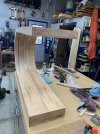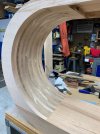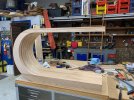My daughter would like for me to build a table approximating this one:
The pictures appear to have veneer wrapped around the curved surfaces. I'm thinking this could be built by edge glueing boards to width and then laminating them to make a bulky blank. After the glue sets, band saw the curves and sand smooth. Sanding the inner curved surface I'm thinking would require a rolling pin style drum sander. I can only plane and band saw 13" so the table would be slightly narrower than the purchased one, but should work similarly. Thinking to use ash with a suitable stain and finish.
One fear is the bottom and top will not remain parallel with changes in humidity with my methodology.
Any constructive criticism to my basic plan would be appreciated.
The pictures appear to have veneer wrapped around the curved surfaces. I'm thinking this could be built by edge glueing boards to width and then laminating them to make a bulky blank. After the glue sets, band saw the curves and sand smooth. Sanding the inner curved surface I'm thinking would require a rolling pin style drum sander. I can only plane and band saw 13" so the table would be slightly narrower than the purchased one, but should work similarly. Thinking to use ash with a suitable stain and finish.
One fear is the bottom and top will not remain parallel with changes in humidity with my methodology.
Any constructive criticism to my basic plan would be appreciated.




